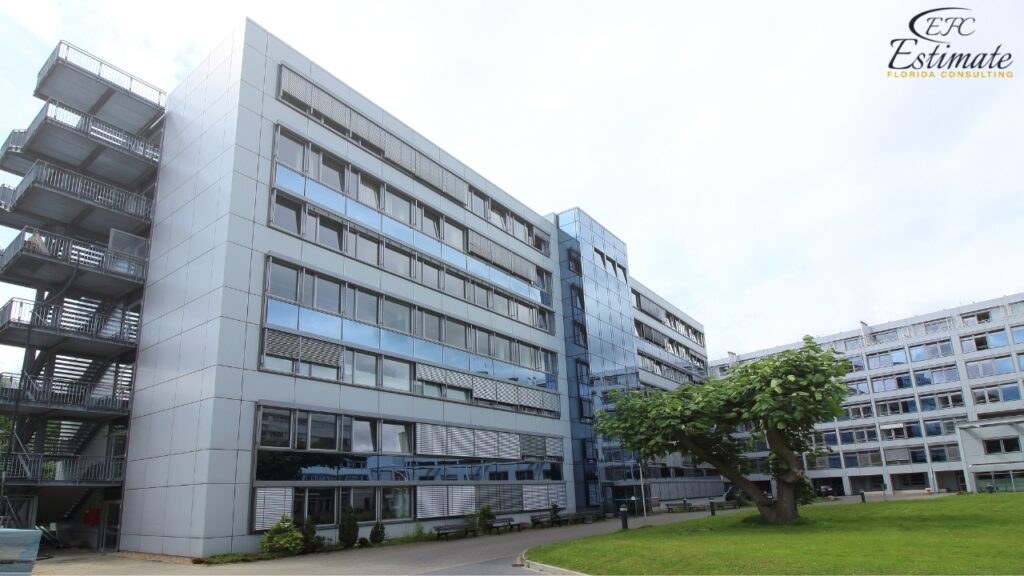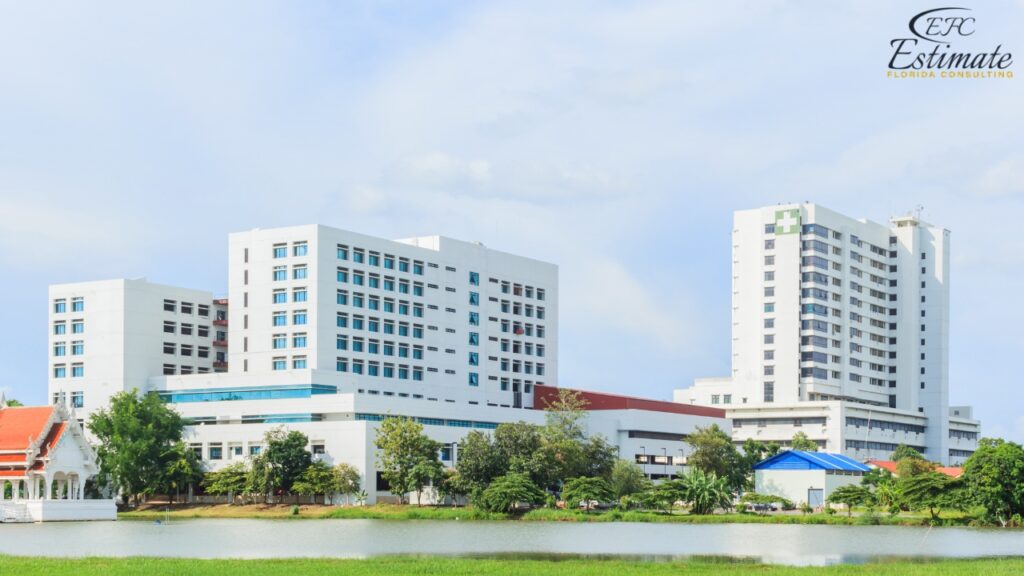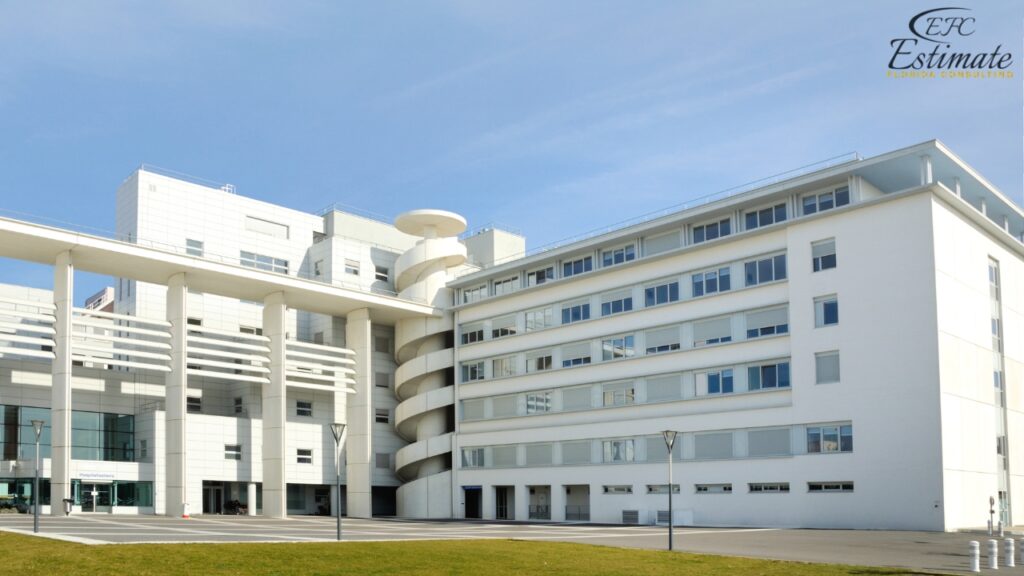How Much Does It Cost to Build a Hospital in the US?
Building a hospital in the US typically costs between $178.29 million and $361.59 million, averaging $400 to $1,000 per square foot. This estimate includes site preparation, construction, interior finishes, medical equipment, HVAC, plumbing, electrical systems, and necessary permits. Costs can vary based on the hospital’s size, design complexity, material quality, and local labor rates. Additional expenses may arise from specialized medical installations, advanced technology integrations, and compliance with health regulations. Investing in quality construction and equipment ensures optimal functionality, durability, and patient care standards. Proper planning and budgeting are essential for a successful hospital construction project.

Key Factors Influencing the Cost
Location
The location of the hospital significantly impacts the construction cost. Urban areas with higher land values and labor costs will generally be more expensive compared to rural locations. The cost differences also reflect varying regulatory environments and infrastructure needs.
Location | Estimated Cost per Sq Ft |
Urban | $650 – $910 |
Suburban | $520 – $780 |
Rural | $390 – $650 |
Urban hospitals tend to have higher costs due to the increased price of land, higher wages for labor, and stricter building codes and regulations. Additionally, building in an urban area might require more advanced infrastructure and utility upgrades. Conversely, rural areas might have lower land and labor costs but could face challenges with accessibility and supply chain logistics, which could impact construction timelines and costs. Urban locations may also offer better access to specialized labor and materials, potentially speeding up the construction process but at a higher cost.
Size of the Hospital
The size of the hospital is a primary factor in determining the overall cost. Larger hospitals with more beds and departments will naturally require more significant investments. The scale of the facility also influences the complexity of the design and the variety of services offered.
Hospital Size | Estimated Total Cost |
Small (50 beds) | $39 million – $65 million |
Medium (150 beds) | $117 million – $195 million |
Large (300 beds) | $234 million – $390 million |
Very Large (500+ beds) | $390 million – $650 million+ |
The size impacts not only the initial construction costs but also the operational expenses. Larger hospitals require more staff, more equipment, and more extensive maintenance. Moreover, larger hospitals often include specialized departments like trauma centers, intensive care units, and advanced diagnostic facilities, which add to both construction and operational costs. These facilities need to be designed to handle a higher volume of patients and more complex medical procedures, further increasing costs. Additionally, larger hospitals may offer a wider range of services and technologies, necessitating more sophisticated infrastructure and more substantial investment in medical equipment.
Type of Facility
The type of hospital also affects the cost. General hospitals are typically less expensive to build than specialized facilities like children’s hospitals or cancer centers, which require unique designs and specialized equipment.
Facility Type | Estimated Cost per Sq Ft |
General Hospital | $520 – $780 |
Children’s Hospital | $585 – $845 |
Specialty Hospital | $650 – $910 |
Specialized hospitals require specific design considerations, such as pediatric care units for children’s hospitals or advanced radiation therapy rooms for cancer centers, which can significantly increase costs. These specialized areas often need customized equipment and layouts to accommodate the specific needs of their patients. For example, children’s hospitals require child-friendly environments, including play areas and family accommodations, which add to the construction costs. Similarly, cancer centers may need advanced imaging and treatment facilities, driving up costs. The specialized nature of these facilities also demands highly skilled staff and tailored operational protocols, further contributing to the overall expense.
Breakdown of Major Cost Components
Land Acquisition and Site Preparation
Acquiring land and preparing the site are crucial initial steps in hospital construction. These costs can vary widely based on location and the condition of the land. The cost of land acquisition can be influenced by factors such as proximity to urban centers, accessibility, and the availability of utilities.
Cost Component | Estimated Cost |
Land Acquisition | $2.6 million – $13 million+ |
Site Preparation | $1.3 million – $6.5 million |
Site preparation includes clearing the land, grading, and ensuring the site is suitable for construction. This phase may also involve demolishing existing structures, environmental remediation, and setting up essential utilities. Proper site preparation is vital to prevent future issues that could arise from unstable ground, poor drainage, or other environmental factors. Ensuring the land is adequately prepared can help avoid costly delays and structural problems in the future. Furthermore, addressing any environmental concerns early in the process can mitigate risks and ensure compliance with environmental regulations, which can be crucial for obtaining necessary permits and avoiding legal complications.
Construction Costs
Construction costs encompass the actual building of the hospital, including labor, materials, and project management. These costs are often the most significant portion of the budget and can vary based on the complexity and scale of the project.
Construction Component | Estimated Cost per Sq Ft |
Labor | $253 – $423 |
Materials | $338 – $507 |
Project Management | $84 – $169 |
Labor
Labor costs are a significant portion of the construction budget. Skilled labor, including architects, engineers, and construction workers, is essential for building a hospital that meets all regulatory standards. Labor costs can be influenced by the availability of skilled workers, regional wage rates, and the project’s complexity. Employing experienced professionals helps ensure that the construction is of high quality and complies with all safety and health regulations. Additionally, labor costs can include overtime for projects on tight schedules and the need for specialized skills for certain phases of the construction, which can add to the overall expense.
Materials
High-quality materials are crucial for constructing a durable and safe hospital. These include steel, concrete, glass, and various finishing materials. The choice of materials can affect both the upfront costs and long-term maintenance expenses. Using durable and sustainable materials can reduce future repair and replacement costs, contributing to the hospital’s overall sustainability and efficiency. Additionally, selecting materials that meet health and safety standards is essential to ensure the well-being of patients and staff. Advanced materials, such as antimicrobial surfaces and energy-efficient windows, can improve the hospital’s functionality and sustainability but may also increase initial costs.

Project Management
Effective project management ensures that the construction stays on schedule and within budget. This includes coordinating all aspects of the project, from initial planning to final inspections. Project managers oversee the workflow, manage resources, and mitigate risks, ensuring that the project adheres to the established timeline and budget. Good project management can help prevent costly delays, manage unexpected issues efficiently, and ensure the project meets all regulatory requirements. Experienced project managers can also optimize the use of resources and streamline communication among various stakeholders, leading to a more efficient and cost-effective construction process.
Medical Equipment and Technology
Equipping a hospital with the necessary medical equipment and technology is another substantial expense. This includes diagnostic machines, surgical instruments, patient monitoring systems, and IT infrastructure. Advanced medical technology is critical for providing high-quality patient care and improving operational efficiency.
Equipment Category | Estimated Total Cost |
Diagnostic Equipment | $8.45 million – $16.9 million |
Surgical Equipment | $5.07 million – $11.83 million |
Patient Monitoring Systems | $3.38 million – $8.45 million |
IT Infrastructure | $3.38 million – $6.76 million |
Advanced medical equipment ensures that the hospital can provide high-quality care to patients. Investing in the latest technology can also improve operational efficiency and patient outcomes. Modern equipment can facilitate faster diagnoses, more precise treatments, and better patient monitoring, enhancing overall care quality. Furthermore, integrating advanced IT systems can streamline administrative processes, improve data management, and support telemedicine services, expanding the hospital’s capabilities. The rapid advancement of medical technology necessitates ongoing investment to keep the hospital at the forefront of medical innovation, which can be a significant but essential cost.
Regulatory Compliance and Permits
Compliance with federal, state, and local regulations is essential for hospital construction. This includes obtaining various permits and ensuring the facility meets healthcare standards. Regulatory compliance is crucial to ensure the hospital is safe, legal, and capable of providing high-quality care.
Regulatory Component | Estimated Cost |
Permits and Inspections | $845,000 – $1.69 million |
Compliance Costs | $1.69 million – $5.07 million |
Ensuring compliance with regulations helps avoid legal issues and ensures the hospital is safe for patients and staff. Regular inspections and adherence to standards are crucial throughout the construction process. Compliance with regulations involves multiple aspects, including building codes, health and safety standards, and environmental regulations. Engaging with regulatory bodies early and throughout the construction process can help identify and address potential compliance issues, avoiding costly revisions and ensuring the hospital meets all necessary standards. Additionally, maintaining transparency and thorough documentation can streamline the approval process and build trust with regulatory agencies.
Get 5 New Leads Next 7Days With Our System
- Multi-Family Building
- Hotel Building
- Hospital Building
- Warehouse Building
- High-Rise Building
- Shopping Complex
Additional Costs
Design and Planning
Designing a hospital involves detailed planning to ensure the facility meets healthcare standards and provides a functional layout for medical staff and patients. Effective design can enhance patient care, improve operational efficiency, and ensure compliance with health regulations.
Design Component | Estimated Cost |
Architectural Design | $5.07 million – $10.14 million |
Engineering Services | $3.38 million – $6.76 million |
Comprehensive design and planning involve creating detailed blueprints, ensuring efficient space utilization, and incorporating necessary safety features. Architects and engineers work together to design a hospital that is both aesthetically pleasing and functional, meeting the needs of patients and staff. Effective design can also incorporate flexibility for future expansions and technological advancements, ensuring the hospital remains state-of-the-art. Collaboration with healthcare professionals during the design phase can also ensure that the facility meets the practical needs of medical staff and enhances patient care.
Utilities and Infrastructure
Installing essential utilities and infrastructure is vital for the operation of the hospital. This includes electrical, plumbing, and HVAC systems, which must be robust and reliable to support the hospital’s operations.
Utility Component | Estimated Cost |
Electrical Systems | $1.69 million – $5.07 million |
Plumbing Systems | $1.69 million – $3.38 million |
HVAC Systems | $3.38 million – $6.76 million |
These systems ensure that the hospital has a continuous supply of electricity, water, and climate control, which are critical for patient care and comfort. Properly designed and installed utilities are essential for maintaining a sterile environment, supporting medical equipment, and ensuring patient and staff safety. Investing in high-quality systems can reduce maintenance costs and improve the hospital’s operational efficiency. Additionally, implementing energy-efficient systems can reduce operational costs and support the hospital’s sustainability goals.
Additional Considerations
Financing Options
Financing the construction of a hospital may involve exploring different options such as loans, grants, and public-private partnerships. Securing adequate financing is crucial for the successful completion of the project and the long-term financial health of the facility.
Financing Option | Estimated Interest Rate |
Construction Loans | 3% – 7% |
Government Grants | Variable |
Public-Private Partnerships | Variable |
Construction loans typically offer flexible financing options tailored to large-scale projects like hospital construction, though they come with varying interest rates based on the lender and creditworthiness of the borrower. Government grants can provide significant financial support, especially for public health initiatives, but securing them can be competitive and require meeting specific criteria. Public-private partnerships can leverage private investment for public projects, spreading financial risk and potentially speeding up project completion.
Sustainability and Green Building
Incorporating sustainable practices and green building techniques can reduce operational costs and environmental impact. Sustainable construction practices not only benefit the environment but can also enhance the hospital’s reputation and appeal to environmentally conscious stakeholders.
Green Building Component | Estimated Additional Cost |
Energy-Efficient Systems | $3.38 million – $8.45 million |
Sustainable Materials | $1.69 million – $5.07 million |
Sustainable practices include using energy-efficient HVAC systems, installing solar panels, and incorporating water-saving fixtures.

Sustainable materials, such as recycled steel and low-VOC paints, can also contribute to a healthier indoor environment. These practices can result in long-term savings through reduced energy and maintenance costs. Additionally, hospitals that achieve green building certifications, such as LEED, can attract more patients and staff who prioritize environmental sustainability.
Download Template For Hospital Building Project Breakdown
- Materials list updated to the zip code
- Fast delivery
- Data base of general contractors and sub-contractors
- Local estimators

Conclusion
Building a hospital in the US is a complex and costly endeavor that requires careful planning and significant financial investment. By understanding the various cost components and factors influencing the budget, stakeholders can create a realistic and comprehensive financial plan. Whether constructing a small rural hospital or a large urban medical center, attention to detail and adherence to regulations are crucial for successful project completion. Working with experienced professionals and considering all relevant factors will lead to a functional, safe, and efficient healthcare facility that serves the community’s needs for years to come. Moreover, ongoing investment in technology, sustainability, and staff training will ensure the hospital remains at the forefront of medical innovation and continues to provide high-quality care.
FAQs
Building a hospital in the US typically costs between $178.29 million and $361.59 million, averaging $400 to $1,000 per square foot. This estimate includes site preparation, construction, interior finishes, medical equipment, HVAC, plumbing, electrical systems, and necessary permits.
Several factors influence the cost, including location, size of the hospital, type of facility, construction costs, medical equipment, regulatory compliance, and additional features like design and utilities.
The location significantly impacts construction costs. Urban areas with higher land values and labor costs will generally be more expensive compared to rural locations. Here’s a breakdown:
Location | Estimated Cost per Sq Ft |
Urban | $650 – $910 |
Suburban | $520 – $780 |
Rural | $390 – $650 |
Urban hospitals tend to have higher costs due to increased land prices, higher wages for labor, and stricter building codes and regulations.
The size of the hospital is a primary factor in determining the overall cost. Larger hospitals with more beds and departments will naturally require more significant investments. Here’s a breakdown:
Hospital Size | Estimated Total Cost |
Small (50 beds) | $39 million – $65 million |
Medium (150 beds) | $117 million – $195 million |
Large (300 beds) | $234 million – $390 million |
Very Large (500+ beds) | $390 million – $650 million+ |
Larger hospitals require more staff, equipment, and extensive maintenance, which increases costs.
The type of hospital affects the cost due to specialized designs and equipment required for specific facilities. Here’s a breakdown:
Facility Type | Estimated Cost per Sq Ft |
General Hospital | $520 – $780 |
Children’s Hospital | $585 – $845 |
Specialty Hospital | $650 – $910 |
Specialized hospitals, such as children’s hospitals or cancer centers, require unique designs and equipment, increasing costs.
The major cost components include land acquisition, site preparation, construction, medical equipment, and regulatory compliance. Here’s a breakdown:
Cost Component | Estimated Cost |
Land Acquisition | $2.6 million – $13 million+ |
Site Preparation | $1.3 million – $6.5 million |
Construction (Labor) | $253 – $423 per sq ft |
Construction (Materials) | $338 – $507 per sq ft |
Project Management | $84 – $169 per sq ft |
Diagnostic Equipment | $8.45 million – $16.9 million |
Surgical Equipment | $5.07 million – $11.83 million |
Patient Monitoring Systems | $3.38 million – $8.45 million |
IT Infrastructure | $3.38 million – $6.76 million |
Permits and Inspections | $845,000 – $1.69 million |
Compliance Costs | $1.69 million – $5.07 million |
Google Reviews



Process To Get It Cost to Build a Hospital Estimate Report
Here I am going to share some steps to get it cost to build a hospital estimate report.
-
You need to send your plan to us.
You can send us your plan on info@estimatorflorida.com
-
You receive a quote for your project.
Before starting your project, we send you a quote for your service. That quote will have detailed information about your project. Here you will get information about the size, difficulty, complexity and bid date when determining pricing.
-
Get Estimate Report
Our team will takeoff and estimate your project. When we deliver you’ll receive a PDF and an Excel file of your estimate. We can also offer construction lead generation services for the jobs you’d like to pursue further.

